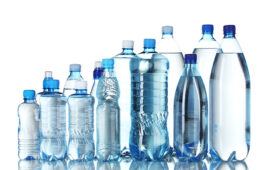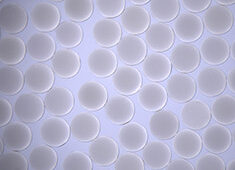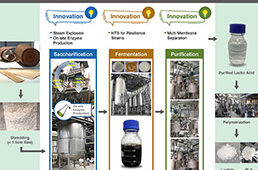This is a still from an animation showing that the formation of “fingers” by a yellow fluid moving through a more viscous fluid causes the two to mix quickly and naturally. Video / Birendra Jha of the Juanes Lab |
Getting
two fluids to mix in small or confined spaces is a big problem in many
industries where, for instance, the introduction of one fluid can help
extract another — like water pumped underground can release oil trapped
in porous rock — or where the mixing of liquids is the essential point
of the process. A key example of the latter is microfluidics technology,
which allows for the controlled manipulation of fluids in miniscule
channels often only a few hundred nanometers wide.
Microfluidic
devices were first introduced in the 1980s and for many years were best
known for their use in ink-jet printers, but have since been introduced
in other fields, including the chemical analysis of blood or other sera
in lab-on-a-chip technologies. These devices — usually not much larger
than a stick of chewing gum — sometimes rely on nano-sized moving
components, the geometry of the grooved channels or pulsed injections to
induce a mixing of the fluids. But researchers in MIT’s Department of
Civil and Environmental Engineering suggest that a simpler method might
be equally, if not more, effective.
“Getting
two fluids to mix in a very tight space is difficult because there’s
not much room for a disorderly flow,” said Professor Ruben Juanes, the
ARCO Associate Professor in Energy Studies and principal investigator on
the research. “But with two fluids of highly contrasting viscosity, the
thinner fluid naturally creates disorder, which proves to be a
marvelously efficient means of mixing.”
In
an analysis published online May 12 in Physical Review Letters (PRL),
the researchers show that the injection of a thin or low-viscosity fluid
into a much more viscous fluid (think of water spurting into molasses)
will cause the two fluids to mix very quickly via a physical process
known as viscous fingering. The thinner liquid, say the researchers,
will form fingers as it enters the thicker liquid, and those fingers
will form other fingers, and so on until the two liquids have mixed
uniformly.
They
also found that for maximum mixing to occur quickly, the ideal ratio of
the viscosity of any two fluids depends on the speed at which the
thinner liquid is injected into the thicker one.
The
research team of Juanes, postdoctoral associate Luis Cueto-Felgueroso
and graduate students Birendra Jha and Michael Szulczewski, made a
series of controlled experiments using mixtures of water and glycerol, a
colorless liquid generally about a thousand times more viscous than
water. By alternating the viscosity of the liquids and the velocity of
the injection flows, Jha was able to create a mathematical model of the
process and use that to determine the best viscosity ratio for a
particular velocity. He is lead author on the PRL paper.
“It’s
been known for a very long time that a low viscosity fluid will finger
through the high viscosity fluid,” said Juanes. “What was not known is
how this affects the mixing rate of the two fluids. For instance, in the
petroleum industry, people have developed increasingly refined models
of how quickly the low viscosity fluid will reach the production well,
but know little about how it will mix once it makes contact with the
oil.”
Similarly,
Juanes said, in microfluidics technology, the use of fluids of
different viscosities has not been seriously proposed as a mixing
mechanism, but the new study indicates it could work very efficiently in
the miniscule channels.
“We
can now say that on average, the viscosity of the fluid injected should
be about 10 times lower than that of the fluid into which it is
injected,” said Juanes. “If the contrast is greater than 10, then the
injection should be done more slowly to achieve the fastest maximum
mixing. Otherwise, the low viscosity fluid will create a single channel
through the thicker fluid, which is not ideal.”
Cueto-Felgueroso
said a similar process is at work in the engraved channels of a
microfluidic device and in subsurface rock containing oil. “Mixing
fluids at small scales or velocities is difficult because you can’t rely
on turbulence: it would be hard to stir milk into your coffee if you
were using a microscopic cup,” Cueto-Felgueroso said. “With viscous
fingering, you let the fluids do the job of stirring.”





